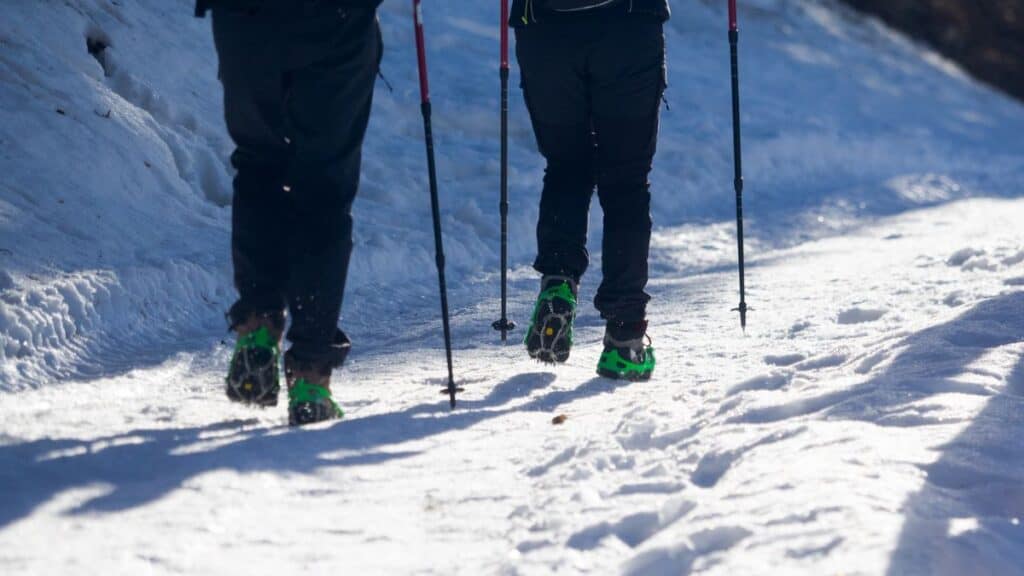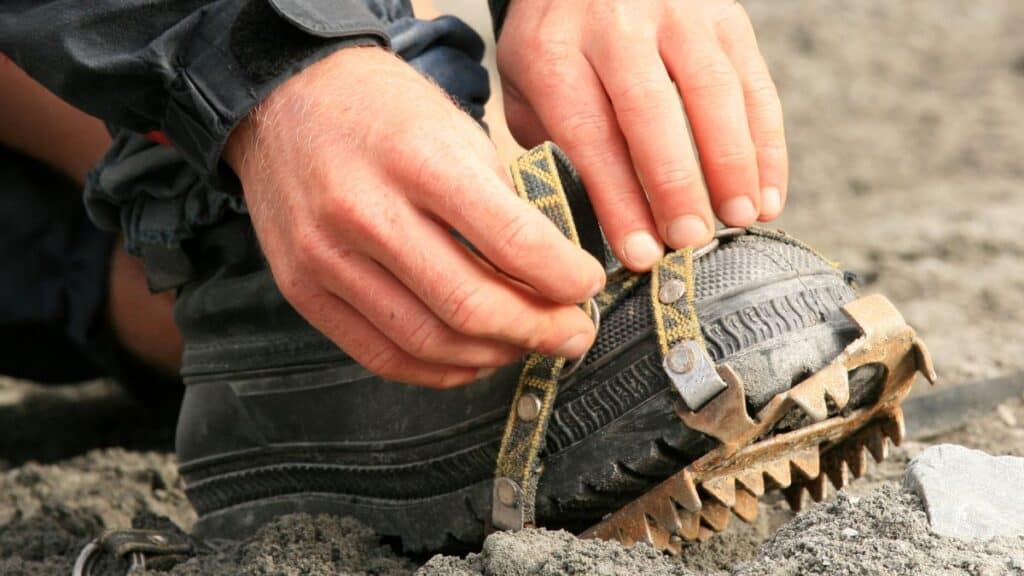
Are you tired of slipping and sliding on icy paths during your winter adventures? Say goodbye to those treacherous moments with the secret weapon of winter hikers and outdoor enthusiasts: microspikes!
Microspikes are traction devices designed to enhance grip and stability while walking or hiking on icy or slippery surfaces. They consist of small, sharp spikes that attach to the soles of footwear, providing increased traction and reducing the risk of slips and falls in wintry conditions.
In this blog post, I’ll unveil the magic behind these compact yet mighty traction devices and how they can revolutionize your winter journeys, keeping you safe and confident every step of the way.
What are Microspikes?
Microspikes are a type of traction device that can be attached to the soles of shoes or boots to provide better grip and stability on icy or snowy surfaces.
They are designed to be lightweight, durable, and easy to use, making them a popular choice among hikers, runners, and other outdoor enthusiasts who need reliable traction in winter conditions.
Definition
Microspikes are made up of a series of small metal spikes or cleats that are attached to a flexible rubber harness.
The spikes are typically made of hardened steel or tungsten carbide, which provides excellent durability and traction on icy and slippery surfaces.
The harness is designed to fit snugly over the sole of a shoe or boot, with a series of chains or straps that help keep the spikes in place.
Materials
Microspikes are typically made from a combination of materials, including steel, rubber, and nylon.
The spikes themselves are usually made from hardened steel or tungsten carbide, which provides excellent durability and traction on icy and slippery surfaces.
The harness is typically made from a flexible rubber material, which allows it to stretch and conform to the shape of the shoe or boot.
Design
Microspikes are designed to be lightweight and easy to use, with a simple design that allows them to be attached and removed quickly and easily.
The spikes are typically arranged in a pattern that provides maximum traction on icy or slippery surfaces, with a series of chains or straps that help keep them in place.
The harness is designed to be flexible and stretchy, allowing it to fit snugly over the sole of a shoe or boot without slipping or shifting.
Usage
Microspikes are designed for use in a variety of winter conditions, including hiking, running, and walking on icy or snowy surfaces.
They are typically used by outdoor enthusiasts who need reliable traction and stability in winter conditions, such as hikers, trail runners, and snowshoers.
Microspikes are easy to attach and remove, making them a convenient and versatile choice for anyone who needs reliable traction in winter conditions.

How to Choose the Right Microspikes
When it comes to choosing the right microspikes, there are a few factors to consider.
Here are some sub-sections to help you make the right choice.
Terrain
The type of terrain you will be hiking on is an important factor in choosing the right microspikes.
If you will be hiking on icy or hard-packed snow, you will need microspikes with longer spikes for better traction.
If you will be hiking on mixed terrain, consider microspikes with a combination of shorter and longer spikes to provide a better grip on both ice and snow.
Activity
The activity you will be doing is also important in choosing the right microspikes. If you will be hiking, consider microspikes with a more aggressive tread pattern for better grip on steep slopes.
If you will be running, consider microspikes with a lighter weight and a more flexible design for better comfort and agility.
Size
Choosing the right size microspikes is crucial for proper fit and performance!
Measure the length and width of your shoes and compare them to the manufacturer’s size chart. If your shoe size falls between two sizes, it is recommended to size up for a better fit.
Fit
A proper fit is essential for optimal performance and safety. Make sure the microspikes fit snugly on your shoes and don’t slip off.
Adjust the straps or bindings to ensure a secure fit. Test the microspikes on different surfaces and slopes to ensure they provide adequate traction.

How to Use Microspikes
Microspikes are a popular traction device for hikers who frequently encounter icy or snowy terrain. Knowing how to properly use them can make all the difference in your hiking experience.
Here are some tips on how to use microspikes.
Putting On and Taking Off
Putting on microspikes is fairly simple.
- First, ensure that your hiking boots or shoes are clean and dry.
- Then, place the microspikes over the toe of your boot or shoe, with the spikes facing downwards.
- Next, secure the front strap of the microspike around the toe of your boot or shoe, making sure it is snug but not too tight.
- Repeat the process for the rear strap, ensuring that the microspike is centered on the bottom of your boot or shoe.
Taking off microspikes is just as easy. Simply loosen the straps and slide the microspike off your boot or shoe!
While there is some variation here between models, you can see that it’s a very simple and straightforward process.
Adjusting the Fit
It is important to make sure that your microspikes fit properly before hitting the trail. A loose microspike can cause discomfort and even injury, while a tight one can restrict blood flow and cause numbness.
To adjust the fit, start by tightening the front strap until it is snug but not too tight.
Then, adjust the rear strap to achieve a comfortable fit. Make sure that the microspike is centered on the bottom of your boot or shoe.
Walking Techniques
Walking with microspikes takes a bit of practice, but it is not difficult to master!
When walking uphill, use your toes to dig into the snow or ice and lean forward slightly to maintain balance. When walking downhill, use your heels to dig in and lean back slightly to avoid slipping.
When walking on flat terrain, take short, deliberate steps, and avoid dragging your feet. This will help prevent the microspikes from catching on the ground and causing you to trip.
Maintenance
Proper maintenance is key to ensuring that your microspikes last for many hiking trips to come. After each use, clean them with a soft brush or cloth to remove any dirt or debris. Store them in a cool, dry place, away from direct sunlight and moisture.
Inspect your microspikes regularly for signs of wear and tear, such as broken spikes or frayed straps. If you notice any damage, replace them immediately to avoid any accidents on the trail.
After heavy use, you may find that your microspike tips wear out slightly. To rectify this issue, you can follow my guide here on how to sharpen microspikes.
By following these tips, you can use your microspikes with confidence and enjoy a safer, more comfortable hiking experience.
Microspike FAQs
When to use crampons vs. microspikes?
Knowing when to use crampons versus microspikes is essential for navigating different winter terrains. Crampons are best employed during technical mountaineering or ice climbing, where more aggressive traction is required.
Their longer, sharper spikes and rigid construction provide a superior grip on steep ice, hard-packed snow, and vertical slopes. In contrast, microspikes are ideal for non-technical winter activities like hiking or trail running on icy or slippery surfaces.
With shorter, less aggressive spikes and a lightweight design, microspikes offer reliable traction on packed snow, icy trails, or icy pavement, enhancing stability and reducing the risk of falls.
To learn more about their differences, don’t miss my full article on crampons vs microspikes.
When should you use microspikes?
Microspikes are best used when encountering icy or slippery conditions during outdoor activities such as hiking, walking, or running in winter. They provide reliable traction and stability on packed snow, icy trails, or icy pavement, reducing the risk of slips and falls.
Whether you’re exploring snowy trails, traversing icy paths, or simply navigating urban environments in wintertime, microspikes offer a lightweight and versatile solution to enhance grip and ensure confident footing.
To learn more about using microspikes, make sure to take a look at my dedicated guide When to Use Microspikes.
What are the best microspikes for hiking?
When it comes to choosing the best microspikes for hiking, several factors come into play. Durability, traction, ease of use, and comfort are crucial considerations.
Some popular options among hikers include the Kahtoola MICROspikes, Hillsound Trail Crampon, and Yaktrax Pro.
These microspikes are renowned for their robust construction, reliable traction on icy surfaces and user-friendly designs that allow for easy attachment and removal.
Additionally, they often feature adjustable sizing to accommodate different shoe sizes and offer comfortable fits for extended periods of use. To learn more about the top options, make sure to take a look at my dedicated article on the best microspikes for hiking.
Are microspikes worth it?
Microspikes are definitely worth considering if you frequently engage in outdoor activities during icy or slippery conditions. They provide added traction and stability, significantly reducing the risk of slips, falls, and potential injuries.
Microspikes are particularly valuable for hikers, trail runners, and walkers who venture into wintry terrains, allowing them to confidently navigate icy trails or packed snow. With their lightweight and compact design, microspikes are easy to carry and can be quickly attached to most types of footwear.
For a more in-depth look into this topic, don’t miss out on my full post Are Microspikes Worth It.
Conclusion on microspikes
Microspikes are an essential tool for anyone who enjoys hiking or trekking in icy or snowy conditions. They are compact and lightweight, making them easy to carry in a backpack.
Microspikes are designed to provide traction on ice and packed snow, making them suitable for light to moderate snow and ice conditions. They consist of a rubberized elastomer harness that fits over your boot and stainless steel chains and spikes that provide traction.
When it comes to choosing between crampons and microspikes, it is important to consider the terrain, weather, and conditions of your hiking trail. Crampons are better suited for more extreme conditions, such as mountaineering or ice climbing, while microspikes are ideal for light to moderate snow and ice conditions.
Some of the best microspikes on the market include the Kahtoola MICROspikes Footwear Traction, which is perfect for winter hiking, backpacking, ice-trekking, and more.
With 12 spikes per foot that are heat-treated stainless steel and 3/8″ long, these microspikes provide excellent traction on slippery surfaces.
Other popular microspikes include the Hillsound Trail Crampon Ultra, which features 18 stainless steel spikes and a lightweight design, and the Yaktrax Pro Traction Cleats, which are made of durable rubber and steel coils.
Overall, microspikes are an excellent investment for anyone who enjoys hiking or trekking in winter conditions. They provide added traction and stability, making it easier and safer to navigate slippery surfaces.
